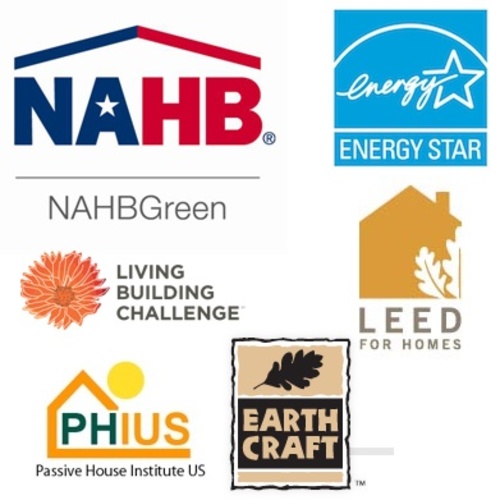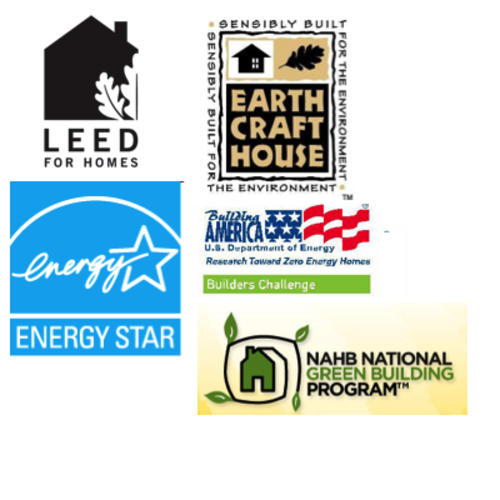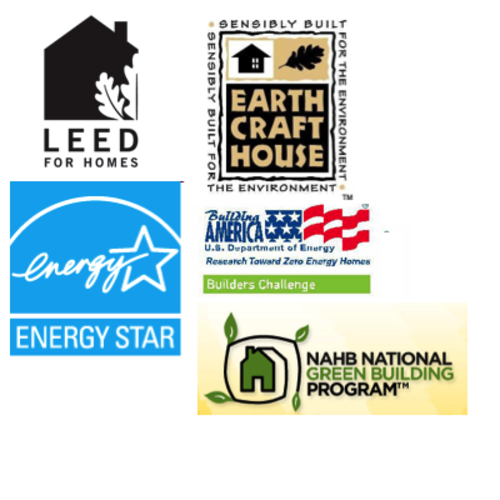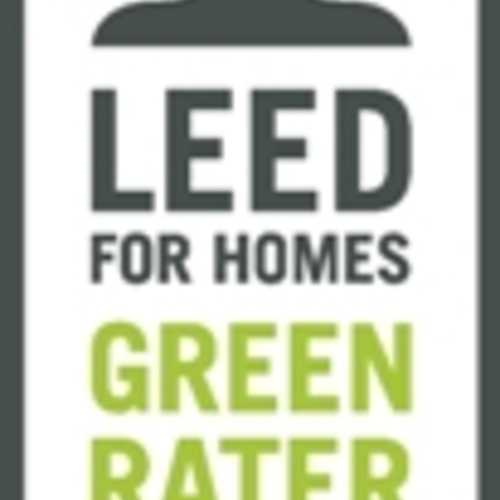
Much of my work these days is certifying homes under LEED, EarthCraft, Energy Star, and the National Green Building Program (NGBP). My day-to-day work includes energy modeling and site inspections, but I find that I spend most of my time explaining and interpreting the different programs to builders, telling them what to do to achieve certification. Each program has minimum requirements, all slightly different. These requirements are not always straightforward or intuitive, and most builders struggle to do them right. The requirements range from straightforward to downright obtuse, and while most of them seem simple to me, on every job I struggle to get the information I need from my clients.
My favorite oddball requirement is the “Framing Waste Order Factor” calculation required for LEED for Homes certification. The builder is required to prepare a document showing that their order does not have more than an average of 10% waste figured into it. Their formula is Waste Factor = (Lumber Ordered-Lumber Needed)/Lumber Needed. No one needs to verify that the actual order is correct, or that there is in fact no more than 10% waste. The intent is good—to not over-order and to minimize waste—but the practice is a rote exercise that most builders do without understanding the point. I find myself challenged to explain the reason behind this requirement; I just let builders know they need to do it.
One of the more logical requirements that is difficult to obtain is an accurate HVAC Manual J Calculation. It seems that few HVAC contractors understand how to prepare an accurate report, often oversizing systems out of habit rather than designing them for the actual house loads. Also, while the reports are supposed to be delivered before the equipment is installed, they rarely are, and mistakes are usually identified well past the time to make any corrections. I recently received a report that included 23 people in a four-bedroom house with window U-factors that were much higher than those actually installed. The house is finished, and I am still waiting for a corrected report.
Is there a better answer out there?
It is certainly a good thing that green building programs are raising the bar, but I am concerned that they may drive away some builders because of their complexity. Making something complicated is a lot harder than making something simple and effective. Fellow Green Policeman Michael Anschel and I have been noodling around with the idea of a more prescriptive green building program. It is little more than an idea, but it would work something like this: Based on your climate, you would choose among a set of pre-determined roof, wall, and floor assemblies, mechanical systems, window and door efficiencies, etc. Any variation from the defined packages would require permission, not unlike the current ID and CIR applications in the LEED for Homes program. A program like this would be much more inclusive and easier to manage than the current programs in the marketplace.
It concerns me that some of the green building programs (and I realize that Energy Star is not actually a green building program, yet), while helping to create high-performance buildings, still have a fairly small impact on our building stock, particularly existing buildings. So what if a tiny fraction of new homes meet LEED, EarthCraft, or NGBP certification? Sometimes I think that I would rather see every building be 10% better than the last one through manageable, incremental changes, than only have a few super high-performing ones.
What’s going to happen next?
One big challenge on the horizon is Energy Star Version 3. Since Energy Star is the base level for most green programs, they are all going to have to raise their own bars significantly very soon. In the current market, some builders are electing to forgo certification of their homes as a cost-reduction strategy. How many more will we lose as the standards (and costs) increase? I am not making the case to lower standards; we do need to continue to raise them. I do believe, however, that we need to make the process simpler in order to keep the industry engaged.
Weekly Newsletter
Get building science and energy efficiency advice, plus special offers, in your inbox.















15 Comments
Hear, hear!
Well said, Carl. As a rater/verifier/technical advisor, you could adopt the warden's line from Cool Hand Luke as your rallying cry: "What we have here is a failure to communicate." The green building programs don't communicate well with raters, and that makes it difficult for you to communicate with the builders, as you described above.
ENERGY STAR is doing a better job communicating with their development and release of the version 3 guidelines, but the difficulty level will make your job with builders harder. I was in on a webinar with Sam Rashkin last year, and I don't recall the number, but he expects a big dropoff in the number of builders participating once version 3 becomes 100% mandatory in 2012.
And the Manual J issue deserves a whole article all by itself!
Thanks Carl
I too, struggle with the "waste factor" calculation for LEED-H. As a matter of supplying material, I often feel as if the wast calculation is an appendix-like requirement to proper materials calculations and use. On the last job I supplied there were 200 pages of backup documentation for the framing takeoff. It was a very accurately figured job, yet I ended up doing another set of calculations for the waste factor prerequisite to meet the provider's documentation requirements for GBCI. On a broader scale, the crux of your article highlights where the bottleneck of information is in the sustainability discussion. Points based green building rating systems do a great job at raising interest in sustainable building practices, and, when the spirit of the credits are met, a good job of directing a positive result. Why you, and I and everyone else is so busy educating as part of our daily grind is that the programs do a poorer job of educating the stakeholders on the overarching intents and ideals behind the prescribed practices. A broader based understanding of the goals is needed, and few programs have any educational offerings that bridge this gap. As far as these programs losing participants, well, hopefully not. These programs are living documents, aimed at furthering the progression of sustainable building practices. The programs should attract leaders, not sheep. Sheep can follow the code. I think there will continue to be a growing interest and market for well-performing homes that are healthy to live in and responsibly built.
Green Programs
Well said! If only the "programs" were listening!
Green in name only
Most of the "green " programs save little energy over the standard fare, there is no financial incentive to buy these homes. The energy savings have to pay for the program and the building upgrades when amortized over the life of the loan.
"The energy savings have to pay when amortized over the loan"
Doug, If my customer signs a thirty year note at $1,800 per month the last payment will still be $1,800 but if it costs him $300 today to fill his propane tank can he assume that it will cost the same in thirty years, or even fifteen?
Do we calculate the payback at today's energy prices or assume a multiplier of perhaps two, or three during the next twenty or thirty years?
I choose to look at both the payback and re-sale value of a fifteen year old house given a fixed loan payment, good durable green construction and reasonable maintenance and an increase that would triple the cost per BTU on energy over the same fifteen years.
That's why I think Green and Energy Star certified (and better) is a very good investment today even with the (subsidized) cost of energy in the US a fraction that in Europe.
Shades of green
Michael,
I am a big fan of energy conservation and have been building far beyond code for over 25 years. My observation tells me we need more teeth in the green building programs. 7 ach50 as a maximum infiltration standard will not promote best practices when it comes to air sealing. As Stephen Tanner said at the 2007 Passive House Conference "Incrementalism is death". We must as builders do more faster in promoting highly efficient buildings, get beyond the feel good stage to real performance.
"Imcrementalism is death"
Doug,
"Incrementalism is death" ? I smell a dogma -- an absolute belief -- and history teaches me to approach those with dogmas like these with great wariness. Leaders who endorse such statements make me nervous.
Of course, as a Vermonter, I'm also made nervous by the slogan on the license plates of New Hampshire vehicles: "Live free or die."
Revolutions espousing such absolutist language usually end poorly...
Incrementalism
I was also struck by the Incrementalism is Death comment by Doug. While I long for the day that all buildings will be super high performance, I have been in construction too long to expect dramatic changes overnight. And as I said in the original post, I am concerned that the increasing complexity of the various certification programs may be driving people away from them rather than embracing them. I have always believed that we would be better off if ever building was just a little better than the one before it - ultimately getting us to very high performance. If the alternative is very few super high performing buildings, while most of the rest are mediocre, I think we are heading down the wrong path. Incrementalism may be the only logical path, given the constraints of the real world.
Miles per Gallon
I find that without measuring certain factors their importance is hard to gauge. Our cars are required to have a MPG sticker and standardized rated mileage so we can generally know what to expect on their energy performance. Until this same sticker is required of our homes we will be in the dark about the whole thing. This *should come from a manual J or some type of energy modeling, but as Carl mentioned before we know how well that has been working out!
We have seen 2000+ sq ft homes with air-source heat pumps sit nicely at the $80-$135 per month TOTAL electric bills for an all-electric house. I have also seen 1200sq ft log cabins suck down $600-$800 per month in oil. Most folks will ask a previous homeowner what the bills were... but for some reason it isn't taken into account as part of a home purchase as much as it should be. The fact that you can have a 'Green Certified' home that is barely %15 better than code energy wise is strange to me... especially when codes are getting updated and your 'green certified' home might not even pass local building code next year!
I must sort of agree on the "Incrementalism is death" issue... however in implementation I think we are talking about extra air sealing with 2x6 walls, fiberglass batts with an inch of blueboard sheathing.... hardly game-changing upgrades when implemented properly. Maybe even go crazy and toss in a fresh air duct to the hvac return. I see it as a simple "quality construction" issue instead of some space-age energy upgrade. I hope the 'green MLS' work and new code and energy star requirements will help this... allowing the lower-quality builders to drop out isn't necessarily a bad thing. Quality not quantity?
The only ones benefitting financially :the programs themselves
The ideas of being green & building green are good, but the reality is that GREEN PROGRAMS are OPPORTUNISTIC businesses who make their money off the back of everyone who tries to be green and at every step of the building process. Why would there be there so many Green Programs otherwise? Because people saw in the GREEN CAUSE an opportunity to make money from whoever want to ride the Green Wave by requiring Certifications, inspections, each of which costing more money the more complicated they are, therefore justifying the jobs and lucrative money making purpose of the GREEN PROGRAMS businesses...
It is sickening! I am the US Sales Manager of Lamco Forest Products, a really green engineered wood, green in all aspects:(you can check it for yourself at http://www.lamcowood.com):
-We recycle degraded small lumber into 100% usable structurally stronger boards
-We have zero waste at our plant, our electricity is made with bio-fuels, we reduce the waste on builders job sites or in modular manufacturing facilities...
-We buy only from sawmills who buy logs from companies with sustainable forestry harvesting practices (practices which have been enforced by laws for over 20years in the province of Quebec, Canada, eventhough FSC does not recognize an equivalence...because they could not charge $25K per year to the small log coops and forestry operations companies...)
-Our engineered wood has 15 to 20 times less glue content than LVL, LSL, OSB etc...
Yet
When I started looking into the various (too many) green programs, I realized they want a fee for each product. We would have to pay it again each year, in addition to some testing (even though all our data has been stamped by an engineer), audit fees, etc...
We are a small company and we may have the best product out there, but the cost to become "certified" with all these programs is so prohibitive! An we would need to hire a full time team just to keep up with the paperwork and red tape!
No builder wants to pay more for our products to be able to say they use "Green Built" or "Green Building Products" or "FSC" etc. certified wood.
If those PROGRAMS were really created for the Being GREEN CAUSE and not profitability of the creators, we would only have 1 program and it would be simple to understand and to follow and adhere to.
Now when you say we should: "choose among a set of pre-determined roof, wall, and floor assemblies, mechanical systems, ....." unfortunately these "predetermined" criteria would probably require another costly annual certification and increase the cost for the end user...
If we can't make green affordable, we will not get the home buyers to buy into it, therefore not the builders, not the product manufacturers... Charging a green certification surcharge at every step of the process just goes against the purpose of the Green Cause.
The best example : we can't even make people buy something made in North America over buying something cheaper made in China.
How much more "NOT GREEN" can something be than something "MADE IN CHINA"...
If there isn't any uniformity,simplification and elimination of too many different green programs, I think all the GREEN PROGRAMS will create is a loss of focus and interest in the Green Cause by the building industry. Which would be sad.
GREEN PROGRAMS are OPPORTUNISTIC businesses????
Melanie
All the CAPS are a bit of a tip-off that the writer may not be all that open to debate but I'll take a swing at this anyway.
If you look closely at the green building standards you will see that you don't need to certify your product as green at all for it to have certification value as a green product. You just need to make the information on it's properties readily available and make your process transparent and verifiable. There are plenty of labels out there wanting to audit and certify for a price but you can still gain value in the market through good practices without being FSC or SFI or even American Tree Farm or GreenGuard certified. Those listings may optimize your green credibility and make it easier to promote your product but they are still optional.
I've been wanting to incorporate TimberSIl lumber (instead of pressure treated) in my projects for some time and they have all sorts of engineers letters and certifications, but without An ICC-ES Evaluation Services report from the International Code Council my inspector won't permit me to use it.
Perhaps you are chasing after the wrong certification as well?
Don't complain publicly if you're not helping in the process
I do not participate formally in the formation of ENERGY STAR, RESNET Standards, or NAHB, but my take is that they try to be as inclusive to public comments as possible and often change their standards in light of public comments. ENERGY STAR is a good example of this, but I'm less familiar with how LEED, NAHB, and the others form their standards. Those working behind the scenes are most often the leaders of our industry with plenty of smarts. It's hard to develop a methodology for assessing the sustainability of anything, but these rules are the best stabs by our best minds who would often take your idea if you give a good one.
That being said, I'm fairly happy with the rate of evolution of our building codes and green building standards. The building code in NC is finally close to what ENERGY STAR V.2, and we'll have air infiltration testing required in 2012. I think the current system allows one to build a super energy efficient and green home all by yourself, a verified energy efficient home under ENERGY STAR, or a verified super energy efficient and green home through the myriad of certifications out there. We do not have the added value today, but I think the industry has to head that way in the next 5 to 10 years. Bankers, appraisers, and Realtors are slowly catching on it seems.
I do agree that Incrementalism is Death sentiment, but don't think the prescriptive alternative works well with the American system. We don't use a top down directed building system. We have those making the standards giving us loose guidelines that builders and manufactures compete with to give the best price. Quint - this quote refers to the passive house system, which is way beyond well constructed 2x6 walls. I just don't see our country's system prescribing everyone in the country to build a passive house or something similar. Don't think the industry would respond well to that. Some folks already think those of us in the green building industry are only opportunistic businesses. Isn't every business opportunistic? Aren't most certifying bodies non-profits?
I think the 2 biggest simplifying actions that could take place are to consolidate the rater, rating and green building certifications (i.e RESNET and BPI become one and LEED, NAHB, and all the others become one). Builders already deal with the building code, a hugely complicated, ever changing standard. I think they could deal with one evolving ENERGY STAR standard, one evolving green building standard, and one Rater/Verifier, too. Consolidating RESNET and BPI would greatly reduce Rater certification and CEU requirement costs, further reducing the price of certifying homes, too!
A targeted and prescriptive approach can simplify green building
Thanks for the blog about the confusion in green building program marketplace. I agree that prescriptive paths are beneficial for some markets, and particularly those that do not yet have the capacity to design net zero buildings.
Earth Advantage Commercial is a green building program developed by EAI specifically for small commercial buildings in Oregon. The energy category of the program consists of the Core Performance Guide- Oregon Edition, a regionally specific prescriptive path for energy efficiency in Oregon's climate zones. Core Performance- Oregon was developed by the New Buildings Institute and is a local version of their national Advanced Buildings Core Performance Guide.
Core Performance –Oregon has guidelines for building design, equipment efficiencies, envelope assemblies, light power densities, and packages of key efficiency strategies that work in concert with Oregon energy codes (even with the adoption of the new 2010 OEESC). Buildings that pursue these measures will typically experience 15%- 30% greater efficiency over existing Oregon energy codes. The Commercial standard adds key measures in the Materials, Health, Water, and Land categories to create a comprehensive green building program. These measures are also specifically designed for the small commercial market sector, and are prescriptive in nature.
While currently in pilot, this regionally specific prescriptive approach has proven to be effective and is getting traction in the local marketplace.
What do you do when you have better info available? Use it?
Incrementalism is not death... Obviously.
But what is the right approach when our culture is experiencing pretty severe effects from our fossil fuel energy consumption and you have the tools to reduce that consumption in a big way (85% in Passive House) rather than incrementally... timid step by timid step? Use 'em? Make everyone use 'em? Probably not.
I respect that we are all in a different position with different clients and that we all need to "build and survive" in one way or another. The Green Building industry is most likely a group like every other group of Americans: Some are here because they honestly (still) love building, care about the material sources and the built environment that we all create and live in... And those who are really here to capitalize on it. We all know going in... There will be some worms in those apples.
Some of these programs (in between the charges) are giving the industry the opportunity to build better projects. Sure theres a lot of them and they are often expensive, wasteful and inefficient, but at least we've got some movement in a direction. Lets keep the pressure on for them to improve along with our projects.
And I have to say that Passive House is my favorite. It delivers the "biggest bang" for the "smallest buck" of all of them. The bang is so big that is scares people. Combine that with a really low cost of measurement and certification and it looks like a really good tool for todays problems.
This does not mean that all buildings now have to be Passive House Standard. Its all still voluntary and good progress. But now that we have the tools, lets begin to use them quickly... and use them because we are Green Builders. It didn't take long for the US to get computers, get dial up, upgrade to cable and now to smart phones with more apps than I can deal with. Heck I'll probably be able rough out a project design on my Iphone with a sketchup app next week... And there isn't even an environmental problem chasing us on the issue.
Incrementalism
I appreciate the point about the "reality" of industry, but honestly, I'd absolutely agree with the statement that "incrementalism is death."
When one evaluates the emerging Planetary Boundaries and sheer scale of the ecological challenges, it is clear that incremental solutions do lead to nothing but more death, as well as disease and disintegrating health and well being, for all species.
I'd phrase it as, Efficiency is ultimately death, especially when evaluated in light of the natural laws of living systems.
The laws of nature, embodied in physics (and building science, for example) are an absolute jurisdiction, with which there is no negotiation. Any industrial "reality" is not actually absolute - we could choose to adapt much more quickly than we have, to this point. Either we do so voluntarily, or "nature" shall for us.
Log in or create an account to post a comment.
Sign up Log in